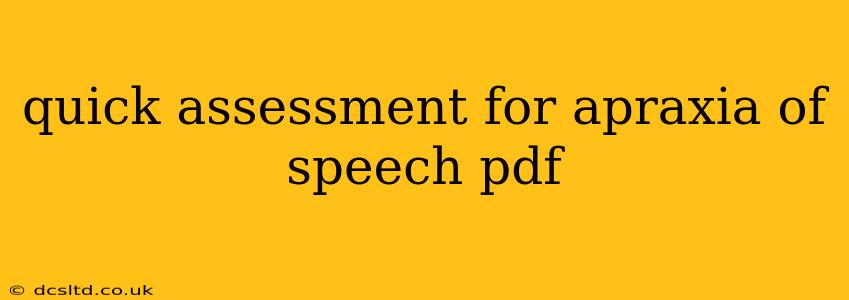Apraxia of speech, also known as verbal apraxia, is a neurological speech disorder affecting the ability to plan and program the movements necessary for speech. A quick and efficient assessment is crucial for early diagnosis and intervention. This guide provides an overview of common assessment methods, emphasizing the importance of a thorough evaluation by a qualified speech-language pathologist (SLP). While this information is intended to be helpful, it is not a substitute for professional assessment.
What is Apraxia of Speech?
Apraxia of speech isn't a problem with muscle weakness or paralysis; rather, it's a difficulty coordinating the muscles involved in speech production. Individuals with apraxia often struggle with the sequencing and precision of sounds, syllables, and words, resulting in inconsistent errors and difficulty with voluntary speech. The severity can vary greatly.
Common Signs of Apraxia of Speech
Several indicators may suggest the presence of apraxia of speech. These include:
- Inconsistent errors: The same word may be pronounced correctly at one time and incorrectly the next.
- Groping: Visible attempts to find the right articulatory position for sounds.
- Difficulty with longer words or phrases: Shorter words are often easier to produce than longer ones.
- Slow rate of speech: Speech may be noticeably slower than typical.
- Prosody problems: Difficulties with the rhythm and intonation of speech.
- Automatic speech (e.g., counting, singing) may be relatively better than volitional speech: This highlights the planning aspect of the disorder.
- Frustration and awareness of errors: Individuals often recognize their speech difficulties.
Quick Assessment Methods – What to Look For (Not a Substitute for Professional Evaluation)
While a comprehensive assessment requires a trained SLP, observing the following can give an initial indication:
- Repetition tasks: Ask the individual to repeat increasingly complex words and phrases (e.g., "pat cake," "bicycle," "no ifs, ands, or buts"). Note consistency of errors and groping behaviors.
- Imitation tasks: Ask the individual to imitate your speech productions. Observe their ability to copy sounds, syllables, and words accurately.
- Naming tasks: Ask the individual to name pictures or objects. Note any difficulties with articulation or word retrieval.
- Sentence production: Request the individual to create simple sentences or describe a picture. Focus on fluency and articulation.
- Conversation: Engage in a short conversation to assess overall speech fluency and ease of communication.
H2: What are the different types of apraxia of speech?
There's not a strict classification of types of apraxia of speech, but the severity and presentation can vary widely depending on the location and extent of brain damage. The descriptions used often focus on the individual's symptoms and the degree of impairment they experience. Some individuals might exhibit milder symptoms affecting primarily articulation, while others experience more severe difficulties with planning and sequencing speech sounds. A thorough assessment by a speech-language pathologist is crucial to determine the specific characteristics and severity of apraxia in each individual.
H2: How is apraxia of speech diagnosed?
Diagnosis of apraxia of speech is made by a speech-language pathologist (SLP) through a comprehensive assessment. This typically involves a thorough evaluation of speech production abilities, including tests of articulation, phonology, fluency, and prosody. The SLP considers the individual's medical history, observes their speech patterns, and utilizes standardized tests and measures to determine a diagnosis. A neurologist's consultation might also be necessary to rule out other neurological conditions. There is no single test for apraxia of speech; diagnosis relies on a combination of clinical observations and assessments.
H2: What are some common assessments used for apraxia of speech?
Several assessments are commonly used by SLPs to evaluate apraxia of speech. These include standardized tests like the Apraxia Battery for Adults (ABA), the Verbal Motor Production Assessment for Children (VMPAC), and other instruments designed to assess articulation, phonology, and sequencing abilities. The specific assessment chosen will depend on factors like the age and cognitive abilities of the individual being evaluated. The SLP will select tools tailored to assess specific skills and aspects of speech production.
H2: What is the difference between apraxia of speech and dysarthria?
Apraxia of speech and dysarthria are both motor speech disorders, but they differ significantly in their underlying causes and symptoms. Apraxia stems from difficulty planning and programming speech movements, while dysarthria results from weakness, incoordination, or paralysis of the muscles involved in speech production. In apraxia, the plan is faulty; in dysarthria, the execution is impaired. Dysarthria often involves consistent errors, whereas apraxia often presents with inconsistent errors. Both conditions can coexist.
Seeking Professional Help
This guide offers a brief overview, but diagnosing and treating apraxia of speech requires the expertise of a qualified SLP. Early intervention is crucial for improving communication skills. If you suspect apraxia of speech, contact a speech-language pathologist for a comprehensive assessment and treatment plan. They will use a variety of methods to determine the nature and severity of the impairment and develop a tailored intervention program.
